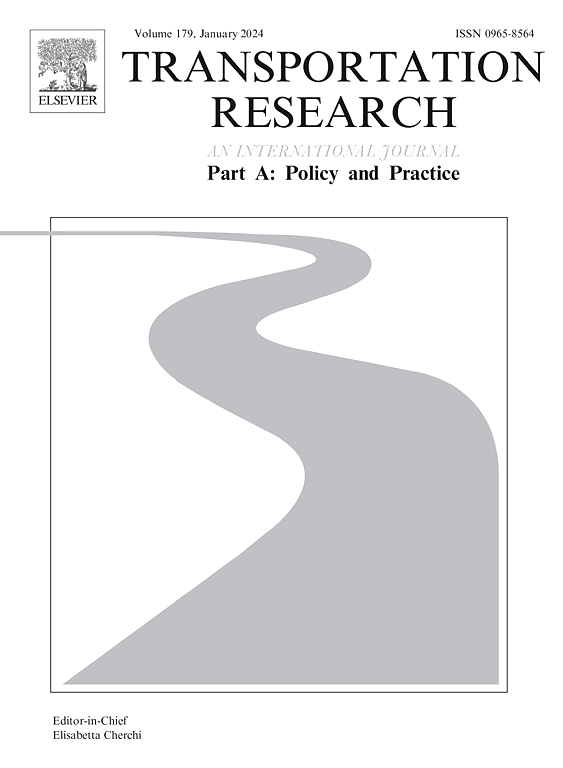Impact of Spatio-Temporal evolution of freeway networks on Socio-Economic Dynamics: A case study from Fujian, China
IF 6.3
1区 工程技术
Q1 ECONOMICS
Transportation Research Part A-Policy and Practice
Pub Date : 2025-05-24
DOI:10.1016/j.tra.2025.104521
引用次数: 0
Abstract
Freeway infrastructures play a pivotal role in driving socio-economic development. However, without a comprehensive understanding of the relationship between freeway network evolution and socio-economic dynamics, it would be difficult to further shape the economic landscape through adjustments in the freeway network layout. To address this challenge, the present study proposes an analytical framework that integrates network, spatial, and temporal elements to quantify the economic stimulatory effects of freeway network evolution. Multiscale geographically and temporally weighted regression (MGTWR) is employed to scrutinize these intricate relationships. This analytical framework is applied to an empirical case study based on the freeway geographic data, point of interest (POI) data, and socio-economic statistics spanning from 2018 to 2021 in Fujian, China. The spatio-temporal impacts of freeway evolution on socio-economic indicators, county-level POI clustering, and roadside POI clustering are investigated. Results demonstrate that considering network elements helps enhance the effectiveness of the analytical framework, and each network element exhibits distinct yet stable effects on socio-economic dynamics. Spatial heterogeneity is identified in the impact of freeway density on socio-economic growths, industrial relocations, and changes in roadside land use patterns. This study provides crucial insights for transportation infrastructure planning and assessment.
高速公路网络时空演变对社会经济动态的影响——以福建省为例
高速公路基础设施在推动社会经济发展中发挥着举足轻重的作用。然而,如果不能全面认识高速公路网演变与社会经济动态的关系,就很难通过调整高速公路网布局来进一步塑造经济格局。为了应对这一挑战,本研究提出了一个整合网络、空间和时间要素的分析框架,以量化高速公路网络演变的经济刺激效应。采用多尺度地理和时间加权回归(MGTWR)来仔细研究这些复杂的关系。该分析框架应用于基于2018年至2021年中国福建省高速公路地理数据、兴趣点(POI)数据和社会经济统计数据的实证案例研究。研究了高速公路演变对社会经济指标、县域POI聚类和公路POI聚类的时空影响。结果表明,考虑网络要素有助于提高分析框架的有效性,并且每个网络要素对社会经济动态表现出不同但稳定的影响。空间异质性主要体现在高速公路密度对社会经济增长、工业转移和路边土地利用模式变化的影响上。该研究为交通基础设施规划和评估提供了重要的见解。
本文章由计算机程序翻译,如有差异,请以英文原文为准。
求助全文
约1分钟内获得全文
求助全文
来源期刊
CiteScore
13.20
自引率
7.80%
发文量
257
审稿时长
9.8 months
期刊介绍:
Transportation Research: Part A contains papers of general interest in all passenger and freight transportation modes: policy analysis, formulation and evaluation; planning; interaction with the political, socioeconomic and physical environment; design, management and evaluation of transportation systems. Topics are approached from any discipline or perspective: economics, engineering, sociology, psychology, etc. Case studies, survey and expository papers are included, as are articles which contribute to unification of the field, or to an understanding of the comparative aspects of different systems. Papers which assess the scope for technological innovation within a social or political framework are also published. The journal is international, and places equal emphasis on the problems of industrialized and non-industrialized regions.
Part A''s aims and scope are complementary to Transportation Research Part B: Methodological, Part C: Emerging Technologies and Part D: Transport and Environment. Part E: Logistics and Transportation Review. Part F: Traffic Psychology and Behaviour. The complete set forms the most cohesive and comprehensive reference of current research in transportation science.

 求助内容:
求助内容: 应助结果提醒方式:
应助结果提醒方式:


